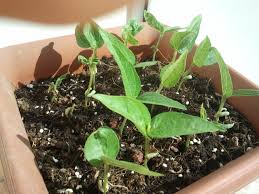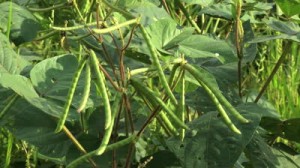![images[1]](https://shouball.com/wp-content/uploads/2015/04/images1.jpg)
The mung bean (Vigna radiata), alternatively known as the moong bean, green gram, lentil, is a plant species in the legume family. Native to the Indian subcontinent, the mung bean is mainly cultivated today in India, China, and South-East Asia. It is also cultivated in hot, dry regions in Southern Europe and the Southern United States. It is used as an ingredient in both savoury and sweet dishes.
Nutrition
The sprouts are rich in bioavailable vitamins, minerals, proteins, amino acids, phytochemicals and energy.
Planting
For outdoor planting, the recommended seeding rate is 15 pounds per acre for wide rows. The soil should have a pH of 6.2 to 7.2, and seedlings sown in a sunny location.
 Seeds can be planted directly in rows, at a depth of 2.5 cm, spaced 5–10 cm apart, and with 75–90 cm between rows.
Seeds can be planted directly in rows, at a depth of 2.5 cm, spaced 5–10 cm apart, and with 75–90 cm between rows.
The pre-sprouting of seeds before sowing is advisable; this can be achieved by soaking the beans in water for 24 hours. Next drain, and leave them for another 24 hours until tiny roots start to poke out. Germinated seeds should then be planted straight away to avoid them drying out.
Sow the germinated beans into compost that is about 5–8 cm, and place tray lids/or other cover over them to keep them warmer during the night. Seedlings should be seen after about two weeks.
Plant Care
Always make sure that the plant-bed is free from weeds, and supply water when required. Do not overwater the plant, as they are susceptible to drowning. Mung beans do best in a light to medium rich soil, although legumes can fix their own nitrogen, you may need to supply a low nitrogen 5-10-5 fertilizer of the soil is poor.
Troubleshooting Growing Problems
The mung bean plant secretes a sticky sweet substance that attracts several kinds of insects. Aphids, mosquitoes, cucumber beetles, and many types of worm are attracted, but can be easily controlled using a mild dose of organic the insecticide pyrethrins.
Harvesting
Mung beans start to form once plants reach a height of 38–45 cm, and are typically ready for harvesting 100 days after sowing. The beans will not mature at the same time, so harvest when about 60% of pods have reached maturity.
 Collect the whole plant, tie into bunches, and then hang upside down to dry out over a large sheet of paper. Once dried it is easy to shell the beans.
Collect the whole plant, tie into bunches, and then hang upside down to dry out over a large sheet of paper. Once dried it is easy to shell the beans.
To reduce seed shattering, the preferred harvest method is direct combining which requires plant to defoliate and dry down in a timely manner. Mung beans planted in May normally dry down and defoliate in September.
Crop Rotation
Companion Planting
Helps
Beets, lettuce, okra, potato, spinach, dill, cabbage, carrots, chards, eggplant, peas, tomatoes, brassicas, corn, cucumbers, grapes
Helped By
savory, beets, cucumbers, borage, cabbage, carrots, cauliflower, corn, larkspur, lovage, marigolds, mustards, radish, potato, peppermint, rosemary, lettuce, onion, squash
Repels
Colorado potato beetle
Avoid
Tomatoes, chilli peppers, alliums, gladiolas
Fertiliser

Leave a Reply
You must be logged in to post a comment.